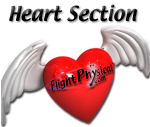Excerpts from AME Guide |
 |
General Physical Examination
Item 36. Heart
- A brief description of any comment-worthy personal characteristics as well as height, weight, representative blood pressure readings in both arms, funduscopic examination, condition of peripheral arteries, carotid artery auscultation, heart size, heart rate, heart rhythm, description of murmurs (location, intensity, timing, and opinion as to significance), and other findings of consequence must be provided.
- The AME should keep in mind some of the special cardiopulmonary demands of flight, such as changes in heart rates at takeoff and landing. High G-forces of aerobatics or agricultural flying may stress both systems considerably. Degenerative changes are often insidious and may produce subtle performance decrements that may require special investigative techniques.
- Inspection. Observe and report any thoracic deformity (e.g., pectus excavatum), signs of surgery or other trauma, and clues to ventricular hypertrophy. Check the hematopoietic and vascular system by observing for pallor, edema, varicosities, stasis ulcers, and venous distention. Check the nail beds for capillary pulsation and color.
- Palpation. Check for thrills and the vascular system for arteriosclerotic changes, shunts, or AV anastomoses. The pulses should be examined to determine their character, to note if they are diminished or absent, and to observe for synchronicity. The medical standards do not specify pulse rates that, per se, are disqualifying for medical certification. These tests are used, however, to determine the status and responsiveness of the cardiovascular system. Abnormal pulse rates may be reason to conduct additional cardiovascular system evaluations.
- Bradycardia of less than 50 beats per minute, any episode of tachycardia during the course of the examination, and any other irregularities of pulse other than an occasional ectopic beat or sinus arrhythmia must be noted and reported. If there is bradycardia, tachycardia, or arrhythmia further evaluation may be warranted and deferral may be indicated.
- A cardiac evaluation may be needed to determine the applicant's qualifications. Temporary stresses or fever may, at times, result in abnormal results from these tests. If the AME believes this to be the case, the applicant should be given a few days to recover and then be retested. If this is not possible, the AME should defer issuance, pending further evaluation.
- Percussion. Determine heart size, diaphragmatic elevation/excursion, abnormal densities in the pulmonary fields, and mediastinal shift.
- Auscultation. Check for resonance, asthmatic wheezing, ronchi, rales, cavernous breathing of emphysema, pulmonary or pericardial friction rubs, quality of the heart sounds, murmurs, heart rate, and rhythm. If a murmur is discovered during the course of conducting a routine FAA examination, report its character, loudness, timing, transmission, and change with respiration. It should be noted whether it is functional or organic and if a special examination is needed. If the latter is indicated, the AME should defer issuance of the medical certificate and transmit the completed FAA Form 8500-8 to the FAA for further consideration. Listen to the neck for bruits.
It is recommended that the AME conduct the auscultation of the heart with the applicant both in a sitting and in a recumbent position.
Aside from murmur, irregular rhythm, and enlargement, the AME should be careful to observe for specific signs that are pathognomonic for specific disease entities or for serious generalized heart disease. Examples of such evidence are: (1) the opening snap at the apex or fourth left intercostal space signifying mitral stenosis; (2) gallop rhythm indicating serious impairment of cardiac function; and (3) the middiastolic rumble of mitral stenosis.
Note: Numbers correspond to the required entry in the AME portion of the FAA Form 8500-8
Note: Numbers correspond to the required entry in the AME portion of the FAA Form 8500-8
